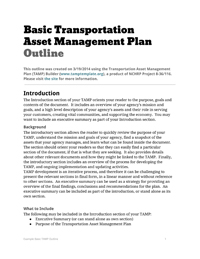Basic TAMP Outline
The Basic TAMP Outline should reflect the minimum requirements established by federal rules. This outline contains guidance on the following sections:
- Introduction
The introduction section of your TAMP orients your reader to the purpose, goals, and contents of the document. It includes an overview of your agency’s mission and goals, and a high-level description of your agency’s assets and their role in serving your customers, serving the economy, and creating vital communities.
- Inventory and Condition
The Inventory and Condition section of your TAMP provides an overview of the assets your agency is responsible for, and a high level description of the current conditions of those assets (e.g. materials, components, age, condition rating, and replacement value).
- Objectives and Measures
The Objectives and Measures section of your TAMP provides an overview of the measures that you are using to track and manage your assets’ performance.
- Performance Assessment
The Performance Assessment section of your TAMP describes how your agency is doing with respect to measures, objectives and level of service goals that relate to asset management.
- Lifecycle Planning
The Lifecycle Planning section of your TAMP describes your agency’s process for management of the lifecycle of your assets.
- Risk Management
The Risk Management section of your TAMP will discuss the concept of risk, how your agency has incorporated it into TAM, and the ways in which the consideration of risk informs maintenance practices, asset replacement or rehabilitation, and emergency response.
- Financial Plan
The Financial Plan section of your TAMP includes details of the funding available for TAM activities, and the how it has been programmed, to date.
- Asset Valuation**
The Asset Valuation section of your TAMP provides a description of how your agency determines the value of your assets. It also includes the current, estimated value of your assets.
- Investment Strategies
The Investment Strategies section of your TAMP describes the process by which your agency translates your data, objectives, measures and policies into decisions about how to spend its constrained resources.
- Process Improvements
The Process Improvements section of your TAMP provides a description of any methods in which your agency is engaged that are designed to measure, and provide input for improvements, to your TAM practice.
The Basic TAMP Outline includes guidance and links to example TAMPs within each section to assist in TAMP development.
**Note that although an asset valuation is a required analysis under federal rules, this analysis is typically presented as part of another required analysis (e.g. inventory and conditions).
Download a basic outline

Along with the Basic TAMP Outline you can also use the Custom Outline Builder to include additional sections and customize your outline with agency-specific criteria. There are many ways to customize your TAMP outline using this tool. Further information is available here.
Distribution of sections in the collected TAMPs
Most of the TAMPs in the AASHTO database contain a number of sections that are not included in the basic outline. This interactive graphic shows which sections are common and which are rare – it charts the percentage of TAMPs in the database that include each section. In this graphic, the sections that comprise the Basic TAMP Outline are indicated in red. As of July 27th, 2024 the set of collected TAMPs includes 80 documents. These can be accessed here.
-
Introduction
-
Regulatory and Legislative Requirements
48%
-
Inventory and Condition
-
Data Management
48%
-
Objectives and Measures
-
Levels of Service
38%
-
Performance Assessment
-
Future Demand
42%
-
Lifecycle Planning/Management
-
Current Methods and Tools
48%
-
Environmental Sustainability
6%
-
Risk Management
-
Financial Plan
-
Asset Valuation
-
Investment Strategies
-
Process Improvements
-
Communications and Reporting
32%
